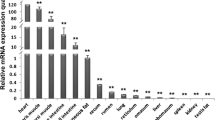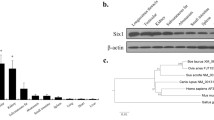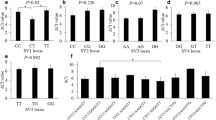Abstract
Myocyte Enhancer Factor 2 (MEF2) proteins are a small family of transcription factors that play pivotal role in morphogenesis and myogenesis of skeletal, cardiac, and smooth muscle cells. In vertebrates, there are four MEF2 genes, referred to as MEF2A, -B, -C, and -D, that are located on different chromosomes. After birth MEF2A, MEF2B, MEF2D transcriptions are expressed ubiquitously, whereas MEF2C transcripts are restricted to skeletal muscle, brain, and spleen. In this study, on the basis of the sequences of the bovine chromosome 7 genomic contig, available in the GenBank database, sets of PCR primers were designed and to amplify the bovine MEF2C gene promoter region, exon 1 (5′UTR) and part sequence of the intron 1. Seven overlapping fragments of the bovine MEF2C gene were amplified and then sequenced. Altogether, these fragments were composed in the 3,120-bp sequence which was deposited in the GenBank database under accession no. GU211007. The sequence fragment included the putative site of the promoter region and transcription start of the exon 1. The sequence analysis of these fragments in individual animals representing different Bos taurus breeds revealed four variations in promoter region: g.-1606C>T, g.-1336_-1335DelG, g.-818C>T, g.-613_-612DelA and four SNPs within intron 1: g.2711A>G, g. 2913A>G, g.2962G>T and g.3014A>G. No polymorphism was found within sequence of the exon 1 (5′UTR). These polymorphisms were identified for first time using these sequences and were confirmed by RFLP or MSSCP methods.
Similar content being viewed by others
Avoid common mistakes on your manuscript.
Introduction
The process of differentiation from mesodermal precursor cells to myoblasts has led to the discovery of a variety of tissue-specific factors that regulate muscle gene expression. The myogenic basic helix-loop-helix proteins, including MyoD, MYOG, MYF5 and MRF4 are one class of identified factors.
Recently, a family of transcription factors, the myocyte enhancer factor-2 (MEF2) family, has been shown to play a pivotal role in morphogenesis and myogenesis of skeletal, cardiac and smooth muscle cells. In vertebrates, there are four MEF2 genes, referred to as MEF2A, -B, -C and -D that are located on different chromosomes [1]. There is a single MEF2 gene in each of the genomes of Drosophila and the intron–exon organization of the MEF2 genes from vertebrates and Drosophila is identical within the conserved regions of the genes, consistent with the notion that they evolved from a common ancestral MEF2 gene [2]. Myocyte enhancer factor 2C is selectively expressed in differentiated myocytes and activates nearly all skeletal and cardiac muscle genes by binding a conserved A/T-rich DNA sequence in the control region of them [3]. MEF2 family share homology within the MADS box domain (56 amino acids), which mediated DNA binding and dimerization. An additional MEF2 domain (29 amino acids), adjacent to the MADS box, is also highly conserved among the MEF2 proteins but is absent from other MADS box proteins [4].
Expression of the MEF2A, -C and -D genes marks early myogenic lineages during mouse and frog embryogenesis. MEF2C is the first member of the family to be expressed in the mouse with transcripts appearing in the precardiac mesoderm at day 7.5 postcoitum. In skeletal muscle cells, MEF2C is expressed within the somite myotome beginning at about 9.0 days postcoitus and Mef2A and -D are expressed immediately thereafter. After birth MEF2A, MEF2B and MEF2D transcripts are expressed ubiquitously. MEF2C transcripts are restricted to skeletal muscle, brain and spleen [5]. Despite all the available information concerning MEF2 genes, little is known about how this gene is regulated at the transcriptional and translational level, especially in bovine. Because of the economic importance of the bovine species to the livestock industry, it appears clearly essential to clarify some of the factors related to MEF2 genes expression.
The present study was conducted to identify new polymorphisms in the promoter region of the bovine MEF2C gene, and to determine the allele distribution in different cattle breeds.
Materials and methods
Animals and DNA samples
Blood samples were collected from unrelated bulls of different breeds: Aberdeen Angus (8), Charolaise (10), Hereford (34), Limousine (27), Simmental (9), Polish Friesian (136) and Polish Red (47). Approximately 10 ml blood was withdrawn from each animal to test tubes containing K2EDTA by an authorised veterinarian. DNA was isolated from blood by the method of Kanai, Furii, Saito & Tokoyama [6]. All procedures involving animals were performed in accordance with the Guiding Principals for the Care and Use of Research Animals and were approved by the Local Ethics Commission (Permission No. 3/2005).
Identification and analysis of polymorphism
Basing on the sequences of the bovine chromosome 7 genomic contig (GenBank acession number: NW_001495275) available in the GenBank database and using the Apollo Genome software (http://www.dhgp.org/current/install.html) were determined sequence two fragments: (1) the 5′noncoding region encompassed site of the promoter region; (2) the exon 1 (5′UTR) and part sequence of the intron 1. Seven pairs of primers were designed using the Primer-BLAST (http://www.ncbi.nlm.nih.gov/tools/primer-blast) to amplify overlapping fragments of the bovine MEF2C gene (Table 1). The PCR reaction was performed in final a volume of 10 μl containing 1.0 μl (30 ng/μl) genomic DNA, 0.5 μl of each primer (10 pmol/μl), 5.1 μl HotStarTag Master Mix (Qiagen, Germany), and 2.9 μl water PCR reagent. The following PCR cycle condition was used: an initial denaturation at 95°C for 15 min; 35 cycles of 95°C for 60 s, 53–61°C (depends on the primer pair used) for 40 s and 72°C for 60–80 s and final elongation at 72°C for 10 min. The yield and specificity of PCR products were evaluated after electrophoresis in 2% agarose gel (Sigma-Aldrich, Germany) with ethidium bromide. Then the PCR products were purified with the GenElute PCR DNA Purification Kit (Sigma-Aldrich, Germany) and sequenced in an ABJ377 sequencer (Applied Biosystem, CA, USA). The sequencing was done at the Polish Academy of Science Institute of Biochemistry and Biophysics, Warsaw. The amplified fragments of the MEF2C gene were sequenced from twenty individual animals belonging to four cattle breeds: Fresian (5), Polish Red (5), Hereford (5) and Limousine (5). Nucleotide sequence alignments were carried out using the Sequencher 4.8 Demo software (www.genecodes.com).
Restriction map of the amplified MEF2C gene fragments was done using Nebcutter software (http://tools.neb.com/NEBcutter2/index.php).
Identified polymorphisms in promoter region were confirmed by RFLP or MSSCP methods. The 382-bp PCR product including P1 fragment was digested for 3 h with 5 U of BsrI (New England Biolabs) restriction endonucleases. The restriction products were separated by electrophoresis in 3% agarose gel (Sigma-Aldrich, Munich, Germany) with ethidium bromide in 1× TBE buffer. Gels was visualised and documented by the Molecular Imager System FX (BioRad, CA, USA).
However, PCR-multitemperature single-strand conformation polymorphism technique was using for PCR products amplified including P2, P4 and P5 fragments. Samples of DNA were prepared according to procedure for MSSCP Starter Kit (Kucharczyk Co., Poland). 1 μl of PCR products were mixed with 5 μl denaturing A buffer. This mixture was heated for 10 min at 98°C and chilled immediately on ice and was added to the samples 2 μl of denaturing B buffer. The mixture was loaded onto a 9% PAGE (polyacrylamide gel, 249 mm × 197 mm) containing 15% glycerol. Electrophoresis was carried out in 0.5× TBE buffer in a DNA Pointer System (Kucharczyk Co., Poland) with 40 W constant power. The gel temperatures were as follows: 35°C for 350 Vh, 15°C for 350 Vh and 5°C for 350 Vh. The total time of electrophoresis was about 70 min. After electrophoresis the gels were silver stained for 30 min using the Silver Stain Kit (Kucharczyk Co., Poland) and then scanned and documented by the Molecular Imager System FX (BioRad, CA, USA).
Genotype and allele frequencies and the Hardy–Weinberg balance were calculated with the use of POPGENE ver. 1.31 software (http://www.ualberta.ca/~fyech). The significance of differences in allele and genotype frequencies was compared with the use of the χ2 test.
Computer analysis
The nucleotide sequence of the promoter region of the MEF2C gene was analyzed for the presence of putative TF-factor binding sites. Sequences with 100% identity to TF-binding sites were searched in TESS software (Schug, J. & Overton, Ch.G.; http://www.cbil.upenn.edu/tess).
Results and discussion
We amplified and then sequenced several overlapping fragments of the noncoding and coding region of the bovine MEF2C gene including promoter region, all sequence of the exon 1 (5′UTR) and part of sequence of the intron 1 (Fig. 1). Altogether, these fragments were composed into a 3,120-bp sequence which was deposited in the GenBank database under accession no GU211007. In this study DNA sequencing method were used to detect genetic variations of the MEF2C gene in seven different cattle breeds. Sequence analysis revealed four polymorphic sites (g.-1606C>T, g.-1336_-1335DelG, g.-818C>T, g.-613_-612DelA) in promoter region and four SNPs in intron 1 (g.2711A>G, g. 2913A>G, g.2962G>T and g.3014A>G) (Fig. 2A, B). Comparison of the restriction maps of the both MEF2C gene variants revealed that the only substitution g.-1606C>T was recognized by BsrI, nuclease, thus enabling the RFLP analysis of the gene polymorphism. SNPs identified within intron 1 were not analyzed by any method. Moreover, for three remaining mutations (g.-1336_-1335DelG, g.-818C>T, g.-613_-612DelA) no any restriction enzyme recognition site were found, and therefore for these mutations we used MSSCP technique (Fig. 3a). Only two genotypes were identified in panel of bulls belonging to seven breeds by using MSSCP method in the relation to variations: g.-1336_-1335DelG, g.-818C>T and g.-613_-612DelA. The heterozygotes G/– (g.-1336_-1335DelG), T/C (g.-818C>T) and A/– (g.-613_-612DelA) appeared very rare and were found only in Fresian and Polish Red breeds; all the three MSSCP loci only one homozygous genotype was found (Table 2).
RFLP/MSSCP genotyping of the two nucleotide substitutions and two deletions in promoter of the bovine MEF2C gene. a RFLP genotyping of the g.-1606C>T with BsrI nuclease; b MSSCP genotyping of the DelG at position -1336_-1335; C MSSCP genotyping of the C/T transition at position -818; D. MSSCP genotyping of the DelA at position -613_-612
Using the RFLP method, the SNP g.-1606C>T was genotyped in 271 bulls from different breeds. After digestion with BsrI nuclease, three CC (129, 122, 117-bp), TT (246, 122-bp) and CT (246, 129, 122, 117-bp) genotypes were identified in the all breeds (Fig. 3b).
The results of χ2 test for different genotypes frequencies were shown in Table 3. No significant differences in genotype frequencies were found within the breed group from the Hardy–Weinberg proportions. The results showed that the occurrence of different genotypes and alleles might vary between breeds. The frequency of allele C varied from 0.654 in Fresian to 0.044 in Hereford, while the frequency of allele T was within the range of 0.346–0.956, respectively. In beef cattle breeds the TT genotype was predominant, but Fresian breed showed the greatest frequency of CC genotype. The CC genotype was not observed in Simental, Charolaise, Hereford and Angus bulls. There was only one CC animal found in the Limousine breed. Probably, it was caused small number of animals within analyzed group of cattle.
Many important traits of domestic animals are controlled by multiple genes and complex gene interaction. The study of candidate genes can be useful to determine whether specific genes are related to the economic traits. The MEF2 proteins are involved in regulation of many muscle specific genes and play active roles in myogenesis, proliferation and differentiation [7]. However, much of the available information about these genes was taken from studies on humans and might not be directly applicable to poultry.
It is known that, from molecular markers that polymorphism at the DNA level is key players in animal genetics. Allelic variation in the regulatory and structural regions of these genes may effect the gene expression or the acid sequence of product and ultimately impact on beef quality traits.
The primary mode of regulation of MEF2 expression during embryogenesis appears to be at the level of mRNA accumulation. In vertebrates MEF2 transcripts are highly enriched in developing muscle cell lineages during embryogenesis. In skeletal muscle cells in culture MEF2D has been reported to be expressed in proliferating myoblasts prior to the onset of differentiation. MEF2A protein appears as cells enter the differentiation pathway, and MEF2C is expressed late in the differentiation program. The significance of these different temporal patterns of MEF2 expression is unclear. In the mouse and chick, MEF2C is the first the MEF2 genes to be expressed, with transcripts appearing initially in mesodermal precursors that give rise to the heart [8]. In adult tissues, transcripts for MEF2C are restricted to skeletal muscle, brain, and spleen, whereas transcripts for the other MEF2 factors are expressed more ubiquitously [9]. Analysis using the TESS software showed that allele C creates a SF1, GATA-1, while the G allele alternatively creates a GATA-2, GATA-3, TBP, NF-E1b binding sites, which are perfectly localized with the C/T transition at position −1,606 bp and may have an influence on the expression level of the MEF2C gene. In the present study genetic variations in bovine MEF2C gene were identified for the first time in this study. The numbers of variations identified in this region were low, suggesting that bovine MEF2C gene is lowly polymorphic. The two substitutions and two InDels were found upstream the putative transcription start of the exon 1. That only g.-1606C>T substitution was recognized with BsrI nuclease and analyzed by RFLP technique. Three remaining SNPs were found only in two Polish breeds, and frequency of heterozygotes was low. The only one mutation the promoter region appeared to have a high frequency in all the genotypes. A minimal frequency of the allele C in beef breed was caused small number of animals which were analyzed. No polymorphism was found in the exon 1, but four substitutions were identified in sequence including part of the intron 1.
Similar polymorphisms have not previously been reported in other species, and its functional significance is unknown. Recently, Zhou et al. [10] described three new polymorphisms in the chicken MEFA gene which were associated with carcass traits in chicken. Authors suggest that the MEF2A gene may be a potential marker affecting muscle trait of chickens.
In summary, newly identified polymorphism (RFLP/BsrI) in the MEF2C gene could be potential genetic markers for carcass and meat quality traits in cattle. The results of this study may be useful in further research supporting associations between polymorphism in the promoter region of the bovine MEF2C gene, gene expression and cattle performance traits.
References
Morisaki T, Semsuvitayawong K, Byun SH, Matsuda Y, Hidaki K et al (1997) Mouse MF2B gene-unique member of MEF2 gee family. J Biochem 122:939–946
Lilly B, Galewsky S, Firulli AB, Schulz RA, Olson EN (1995) D-MEF2: a MADS box transcription factor expressed in differentiating mesoderm and muscle cell lineages during Drosophila embryogenesis. Proc Natl Acad Sci USA 91:5662–5666
Pollock R, Treisman R (1991) Human SFR-related proteins: DNA-binding properties and potential regulatory targets. Genes Dev 5:2327–2341
Black BL, Olson EN (1998) Transcriptional control of muscle development by myocyte enhancer factor-2 (MEF2) proteins. Annu Rev Cell Dev Biol 14:167–196
Subramanian SV, Nadal-Ginard B (1996) Early expression of the different isoforms of the myocyte enhancer factor-2 (MEF2) protein in myogenic as well as non-myogenic cell lineages during mouse embryogenesis. Mech Dev 57:103–112
Kanai N, Fujii T, Saito K, Yokoyama T (1994) Rapid and simple method for preparation of genomic DNA from easily obtainable clotted blood. J Clin Pathol 47:1043–1044
Olson EN, Perry M, Schulz RA (1995) Regulation of muscle differentiation by the MEF2 family of MADS box transcription factors. Dev Biol 172:2–14
Edmondson DG, Cheng TC, Martin JF, Olson EN (1994) MEF2 gene expression marks the cardiac and skeletal muscle lineages during mouse embryogenesis. Development 120:1251–1263
Black BL, Lu J, Olson EN (1997) The MEF2A 3′untranslated region functions as a cis-acting translational repressor. Mol Cell Biol 17:2756–2763
Zhou Y, Liu Y, Xiaosong J, Du H, Xiaocheng L, Zhu Q (2010) Polymorphism of chicken myocyte-specific enhancer-binding factor 2A gene and its association with chicken carcass traits. Mol Biol Rep 37:587–594
Acknowledgment
This study was funded by the Ministry of Scientific Research and Information Technology, grant no. NN311 034834 and the IGHZ project S.V.9.
Open Access
This article is distributed under the terms of the Creative Commons Attribution Noncommercial License which permits any noncommercial use, distribution, and reproduction in any medium, provided the original author(s) and source are credited.
Author information
Authors and Affiliations
Corresponding author
Rights and permissions
Open Access This is an open access article distributed under the terms of the Creative Commons Attribution Noncommercial License (https://creativecommons.org/licenses/by-nc/2.0), which permits any noncommercial use, distribution, and reproduction in any medium, provided the original author(s) and source are credited.
About this article
Cite this article
Juszczuk-Kubiak, E., Flisikowski, K. & Wicińska, K. Nucleotide sequence and variations of the bovine myocyte enhancer factor 2C (MEF2C) gene promoter in Bos Taurus cattle. Mol Biol Rep 38, 1269–1276 (2011). https://doi.org/10.1007/s11033-010-0226-8
Received:
Accepted:
Published:
Issue Date:
DOI: https://doi.org/10.1007/s11033-010-0226-8







